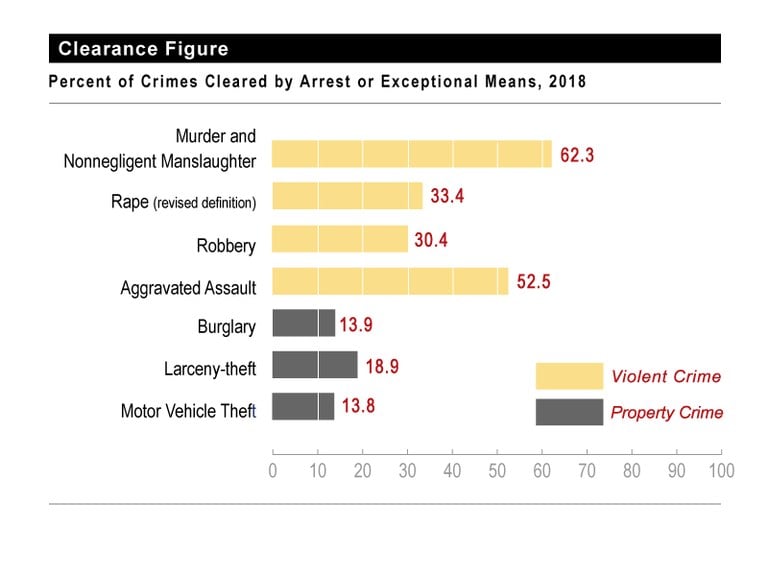Clearances
Offenses Cleared
In the FBI’s Uniform Crime Reporting (UCR) Program, law enforcement agencies can clear, or “close,” offenses in one of two ways: by arrest or by exceptional means. Although an agency may administratively close a case, that does not necessarily mean that the agency can clear the offense for UCR purposes. To clear an offense within the UCR Program’s guidelines, the reporting agency must adhere to certain criteria, which are outlined in the following text. (Note: The UCR Program does not distinguish between offenses cleared by arrest and those cleared by exceptional means in collecting or publishing data via the traditional Summary Reporting System.)
Cleared by arrest
In the UCR Program, a law enforcement agency reports that an offense is cleared by arrest, or solved for crime reporting purposes, when three specific conditions have been met. The three conditions are that at least one person has been:
-
Arrested.
-
Charged with the commission of the offense.
-
Turned over to the court for prosecution (whether following arrest, court summons, or police notice).
In its clearance calculations, the UCR Program counts the number of offenses that are cleared, not the number of persons arrested. The arrest of one person may clear several crimes, and the arrest of many persons may clear only one offense. In addition, some clearances that an agency records in a particular calendar year, such as 2018, may pertain to offenses that occurred in previous years.
Cleared by exceptional means
In certain situations, elements beyond law enforcement’s control prevent the agency from arresting and formally charging the offender. When this occurs, the agency can clear the offense exceptionally. Law enforcement agencies must meet the following four conditions in order to clear an offense by exceptional means. The agency must have:
-
Identified the offender.
-
Gathered enough evidence to support an arrest, make a charge, and turn over the offender to the court for prosecution.
-
Identified the offender’s exact location so that the suspect could be taken into custody immediately.
-
Encountered a circumstance outside the control of law enforcement that prohibits the agency from arresting, charging, and prosecuting the offender.
Examples of exceptional clearances include, but are not limited to, the death of the offender (e.g., suicide or justifiably killed by police or citizen); the victim’s refusal to cooperate with the prosecution after the offender has been identified; or the denial of extradition because the offender committed a crime in another jurisdiction and is being prosecuted for that offense. In the UCR Program, the recovery of property alone does not clear an offense.
Clearances involving only persons under 18 years of age
When an offender under the age of 18 is cited to appear in juvenile court or before other juvenile authorities, the UCR Program considers the incident for which the juvenile is being held responsible to be cleared by arrest, even though a physical arrest may not have occurred. When clearances involve both juvenile and adult offenders, those incidents are classified as clearances for crimes committed by adults. Because the clearance percentages for crimes committed by juveniles include only those clearances in which no adults were involved, the figures in this publication should not be used to present a definitive picture of juvenile involvement in crime.
Overview
-
In the nation in 2018, 45.5 percent of violent crimes and 17.6 percent of property crimes were cleared by arrest or exceptional means.
-
When considering clearances of violent crimes, 62.3 percent of murder offenses,52.5 percent of aggravated assault offenses, 33.4 percent of rape offenses, and 30.4 percent of robbery offenses were cleared.
-
Among property crimes, 18.9 percent of larceny-theft offenses, 13.9 percent of burglary offenses, and 13.8 percent of motor vehicle theft offenses were cleared.
-
In 2018, 22.4 percent of arson offenses were cleared by arrest or exceptional means.
Clearance Figure


